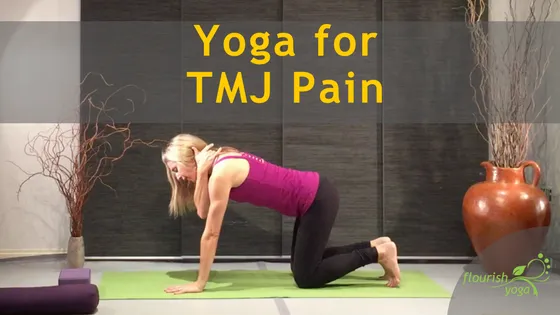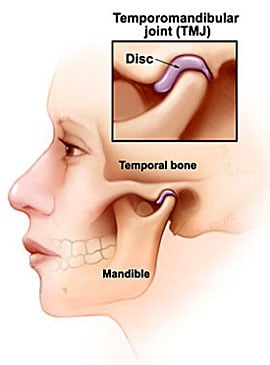Ayurvedic Tips & Essential Self Care Rituals

Learning is the heartbeat of the Flourish Community.
On the Flourish Blog you’ll find everything you need to live in tune with nature; Ayurvedic tips, yoga and essential oil classes, essential self care rituals, essential oil meditations and kids yoga and mindfulness activities where this all started.
Ayurvedic Tips

Yoga for TMJ Pain Relief
Yoga helps so many conditions in the body but perhaps the best results can be seen with the very common jaw pain and teeth grinding. Yoga for TMJ pain relieves symptoms, corrects body alignment causing or exacerbating the pain and breaks the stress and tension cycle.
I was surprised (and concerned) in my teen class at the number of students who nodded their heads at experiencing TMJ stress and pain. While massaging the jaw joint at the beginning of class I could tell by their faces that this felt good, which it only really does if there is underlying pain. I could not believe that at age 12 – 16 this pain is already a factor.
TMJ tension has been my story for the past 6 months resulting from an accident. It took several months to get my habits in place but I’m finally doing all the things I “should” be doing to ensure proper healing; massage, oils, stretching and releasing the ever present tension. Critical to my healing is to do a few yoga poses every morning to release the tension in the neck and shoulder area.
Do you have TMJ pain?

It’s estimated that 20% of the population suffer from jaw pain. The jaw joint, officially called the Temporomandibular Joint, is responsible for nourishment, communication and the expression or emotions. The bone is not very large and the muscles around it are very powerful. Not a great combination when it goes out of alignment. The joint is made up of a ball and socket joint and a small disc that fits between the Condyle (ball end of the jaw bone) and the Glenoid Fossa (the socket notched into the Temporal bone).
Women are three times as likely to suffer from TMJ pain than men. This is possibly the result of a difference in the collagen in the disc causing it to slip out of place more often. Some studies point to an increase of estrogen levels being linked to higher instances of TMD. Or perhaps women tend to have more suppressed feelings and emotions…
Pain in the jaw area can be caused by the joint misalignment, the disc slipping out of place, or pressure on the joint from muscle tension. Pain and misalignment in the area is referred to as TMD or Temporomandibular Disorder.
Symptoms of TMD

• Clicking or popping sounds when you open your jaw.
• A grating sound or sensation with jaw opening.
• Headaches that start at the front of the ear and spread to the back of the neck.
• Tension headaches near the temples.
• Muscle spasms that may make it difficult to open the mouth.
• Jaw joint sticking open, or difficult to close.
• Tenderness or pain along the jawline anywhere from the front of the ear to the jawline.
• Pain while chewing or talking or opening your mouth wide.
• Excessive wear on teeth from misalignment or teeth grinding.
Treatment of TMJ pain, or TMD, includes orthodontic alignment, surgery to reposition the jaw, wearing a splint while sleeping, and reducing stress (aka yoga and meditation). The easiest of these and less invasive is definitely reducing and managing your daily stress and releasing muscle tension in the area.
Why Yoga Helps Relieve TMJ Pain
Whether your TMJ pain is caused by; the orientation of your jaw and teeth, a misalignment within the body that’s putting strain on the joint, or by holding stress in the jaw area reduce your stress levels with yoga and meditation to relax the joint area and re-align your body to its neutral location.

All yoga poses will help. The poses often suggested are gentle poses that encourage blood flow to the area, help to re-align the spine, and release tension from the surrounding area. These include shoulder and neck releases, twists and hip openers, gentle inversions such as downward dog, shoulder stand, and bridge pose. If you are in acute pain then shoulderstand poses might be too much.
Enjoy this gentle series with a relaxing meditation to start to be used daily when your pain is flaring up.
Listen to the meditation starting this series on its own before you go to bed and when you get up in the morning if you are grinding your teeth at night. Relaxing the area helps break the stress habit while you sleep.
Yoga for TMJ Pain
Get Relief for Your Jaw Pain
Get into your comfy clothes and follow along to relieve your jaw stress. Then download the opening meditation and listen every evening and morning if you are grinding your teeth to help break the cycle of stress.
How do you feel?
Bookmark this page to have it handy to do these yoga poses for TMD every morning or evening for week and let me know how it helps in the comments below.
Ayurvedic Essential Oils

Yoga for TMJ Pain Relief
Yoga helps so many conditions in the body but perhaps the best results can be seen with the very common jaw pain and teeth grinding. Yoga for TMJ pain relieves symptoms, corrects body alignment causing or exacerbating the pain and breaks the stress and tension cycle.
I was surprised (and concerned) in my teen class at the number of students who nodded their heads at experiencing TMJ stress and pain. While massaging the jaw joint at the beginning of class I could tell by their faces that this felt good, which it only really does if there is underlying pain. I could not believe that at age 12 – 16 this pain is already a factor.
TMJ tension has been my story for the past 6 months resulting from an accident. It took several months to get my habits in place but I’m finally doing all the things I “should” be doing to ensure proper healing; massage, oils, stretching and releasing the ever present tension. Critical to my healing is to do a few yoga poses every morning to release the tension in the neck and shoulder area.
Do you have TMJ pain?

It’s estimated that 20% of the population suffer from jaw pain. The jaw joint, officially called the Temporomandibular Joint, is responsible for nourishment, communication and the expression or emotions. The bone is not very large and the muscles around it are very powerful. Not a great combination when it goes out of alignment. The joint is made up of a ball and socket joint and a small disc that fits between the Condyle (ball end of the jaw bone) and the Glenoid Fossa (the socket notched into the Temporal bone).
Women are three times as likely to suffer from TMJ pain than men. This is possibly the result of a difference in the collagen in the disc causing it to slip out of place more often. Some studies point to an increase of estrogen levels being linked to higher instances of TMD. Or perhaps women tend to have more suppressed feelings and emotions…
Pain in the jaw area can be caused by the joint misalignment, the disc slipping out of place, or pressure on the joint from muscle tension. Pain and misalignment in the area is referred to as TMD or Temporomandibular Disorder.
Symptoms of TMD

• Clicking or popping sounds when you open your jaw.
• A grating sound or sensation with jaw opening.
• Headaches that start at the front of the ear and spread to the back of the neck.
• Tension headaches near the temples.
• Muscle spasms that may make it difficult to open the mouth.
• Jaw joint sticking open, or difficult to close.
• Tenderness or pain along the jawline anywhere from the front of the ear to the jawline.
• Pain while chewing or talking or opening your mouth wide.
• Excessive wear on teeth from misalignment or teeth grinding.
Treatment of TMJ pain, or TMD, includes orthodontic alignment, surgery to reposition the jaw, wearing a splint while sleeping, and reducing stress (aka yoga and meditation). The easiest of these and less invasive is definitely reducing and managing your daily stress and releasing muscle tension in the area.
Why Yoga Helps Relieve TMJ Pain
Whether your TMJ pain is caused by; the orientation of your jaw and teeth, a misalignment within the body that’s putting strain on the joint, or by holding stress in the jaw area reduce your stress levels with yoga and meditation to relax the joint area and re-align your body to its neutral location.

All yoga poses will help. The poses often suggested are gentle poses that encourage blood flow to the area, help to re-align the spine, and release tension from the surrounding area. These include shoulder and neck releases, twists and hip openers, gentle inversions such as downward dog, shoulder stand, and bridge pose. If you are in acute pain then shoulderstand poses might be too much.
Enjoy this gentle series with a relaxing meditation to start to be used daily when your pain is flaring up.
Listen to the meditation starting this series on its own before you go to bed and when you get up in the morning if you are grinding your teeth at night. Relaxing the area helps break the stress habit while you sleep.
Yoga for TMJ Pain
Get Relief for Your Jaw Pain
Get into your comfy clothes and follow along to relieve your jaw stress. Then download the opening meditation and listen every evening and morning if you are grinding your teeth to help break the cycle of stress.
How do you feel?
Bookmark this page to have it handy to do these yoga poses for TMD every morning or evening for week and let me know how it helps in the comments below.
Yoga and Essential Oils

Yoga for TMJ Pain Relief
Yoga helps so many conditions in the body but perhaps the best results can be seen with the very common jaw pain and teeth grinding. Yoga for TMJ pain relieves symptoms, corrects body alignment causing or exacerbating the pain and breaks the stress and tension cycle.
I was surprised (and concerned) in my teen class at the number of students who nodded their heads at experiencing TMJ stress and pain. While massaging the jaw joint at the beginning of class I could tell by their faces that this felt good, which it only really does if there is underlying pain. I could not believe that at age 12 – 16 this pain is already a factor.
TMJ tension has been my story for the past 6 months resulting from an accident. It took several months to get my habits in place but I’m finally doing all the things I “should” be doing to ensure proper healing; massage, oils, stretching and releasing the ever present tension. Critical to my healing is to do a few yoga poses every morning to release the tension in the neck and shoulder area.
Do you have TMJ pain?

It’s estimated that 20% of the population suffer from jaw pain. The jaw joint, officially called the Temporomandibular Joint, is responsible for nourishment, communication and the expression or emotions. The bone is not very large and the muscles around it are very powerful. Not a great combination when it goes out of alignment. The joint is made up of a ball and socket joint and a small disc that fits between the Condyle (ball end of the jaw bone) and the Glenoid Fossa (the socket notched into the Temporal bone).
Women are three times as likely to suffer from TMJ pain than men. This is possibly the result of a difference in the collagen in the disc causing it to slip out of place more often. Some studies point to an increase of estrogen levels being linked to higher instances of TMD. Or perhaps women tend to have more suppressed feelings and emotions…
Pain in the jaw area can be caused by the joint misalignment, the disc slipping out of place, or pressure on the joint from muscle tension. Pain and misalignment in the area is referred to as TMD or Temporomandibular Disorder.
Symptoms of TMD

• Clicking or popping sounds when you open your jaw.
• A grating sound or sensation with jaw opening.
• Headaches that start at the front of the ear and spread to the back of the neck.
• Tension headaches near the temples.
• Muscle spasms that may make it difficult to open the mouth.
• Jaw joint sticking open, or difficult to close.
• Tenderness or pain along the jawline anywhere from the front of the ear to the jawline.
• Pain while chewing or talking or opening your mouth wide.
• Excessive wear on teeth from misalignment or teeth grinding.
Treatment of TMJ pain, or TMD, includes orthodontic alignment, surgery to reposition the jaw, wearing a splint while sleeping, and reducing stress (aka yoga and meditation). The easiest of these and less invasive is definitely reducing and managing your daily stress and releasing muscle tension in the area.
Why Yoga Helps Relieve TMJ Pain
Whether your TMJ pain is caused by; the orientation of your jaw and teeth, a misalignment within the body that’s putting strain on the joint, or by holding stress in the jaw area reduce your stress levels with yoga and meditation to relax the joint area and re-align your body to its neutral location.

All yoga poses will help. The poses often suggested are gentle poses that encourage blood flow to the area, help to re-align the spine, and release tension from the surrounding area. These include shoulder and neck releases, twists and hip openers, gentle inversions such as downward dog, shoulder stand, and bridge pose. If you are in acute pain then shoulderstand poses might be too much.
Enjoy this gentle series with a relaxing meditation to start to be used daily when your pain is flaring up.
Listen to the meditation starting this series on its own before you go to bed and when you get up in the morning if you are grinding your teeth at night. Relaxing the area helps break the stress habit while you sleep.
Yoga for TMJ Pain
Get Relief for Your Jaw Pain
Get into your comfy clothes and follow along to relieve your jaw stress. Then download the opening meditation and listen every evening and morning if you are grinding your teeth to help break the cycle of stress.
How do you feel?
Bookmark this page to have it handy to do these yoga poses for TMD every morning or evening for week and let me know how it helps in the comments below.
Essential Oil Meditations

Yoga for TMJ Pain Relief
Yoga helps so many conditions in the body but perhaps the best results can be seen with the very common jaw pain and teeth grinding. Yoga for TMJ pain relieves symptoms, corrects body alignment causing or exacerbating the pain and breaks the stress and tension cycle.
I was surprised (and concerned) in my teen class at the number of students who nodded their heads at experiencing TMJ stress and pain. While massaging the jaw joint at the beginning of class I could tell by their faces that this felt good, which it only really does if there is underlying pain. I could not believe that at age 12 – 16 this pain is already a factor.
TMJ tension has been my story for the past 6 months resulting from an accident. It took several months to get my habits in place but I’m finally doing all the things I “should” be doing to ensure proper healing; massage, oils, stretching and releasing the ever present tension. Critical to my healing is to do a few yoga poses every morning to release the tension in the neck and shoulder area.
Do you have TMJ pain?

It’s estimated that 20% of the population suffer from jaw pain. The jaw joint, officially called the Temporomandibular Joint, is responsible for nourishment, communication and the expression or emotions. The bone is not very large and the muscles around it are very powerful. Not a great combination when it goes out of alignment. The joint is made up of a ball and socket joint and a small disc that fits between the Condyle (ball end of the jaw bone) and the Glenoid Fossa (the socket notched into the Temporal bone).
Women are three times as likely to suffer from TMJ pain than men. This is possibly the result of a difference in the collagen in the disc causing it to slip out of place more often. Some studies point to an increase of estrogen levels being linked to higher instances of TMD. Or perhaps women tend to have more suppressed feelings and emotions…
Pain in the jaw area can be caused by the joint misalignment, the disc slipping out of place, or pressure on the joint from muscle tension. Pain and misalignment in the area is referred to as TMD or Temporomandibular Disorder.
Symptoms of TMD

• Clicking or popping sounds when you open your jaw.
• A grating sound or sensation with jaw opening.
• Headaches that start at the front of the ear and spread to the back of the neck.
• Tension headaches near the temples.
• Muscle spasms that may make it difficult to open the mouth.
• Jaw joint sticking open, or difficult to close.
• Tenderness or pain along the jawline anywhere from the front of the ear to the jawline.
• Pain while chewing or talking or opening your mouth wide.
• Excessive wear on teeth from misalignment or teeth grinding.
Treatment of TMJ pain, or TMD, includes orthodontic alignment, surgery to reposition the jaw, wearing a splint while sleeping, and reducing stress (aka yoga and meditation). The easiest of these and less invasive is definitely reducing and managing your daily stress and releasing muscle tension in the area.
Why Yoga Helps Relieve TMJ Pain
Whether your TMJ pain is caused by; the orientation of your jaw and teeth, a misalignment within the body that’s putting strain on the joint, or by holding stress in the jaw area reduce your stress levels with yoga and meditation to relax the joint area and re-align your body to its neutral location.

All yoga poses will help. The poses often suggested are gentle poses that encourage blood flow to the area, help to re-align the spine, and release tension from the surrounding area. These include shoulder and neck releases, twists and hip openers, gentle inversions such as downward dog, shoulder stand, and bridge pose. If you are in acute pain then shoulderstand poses might be too much.
Enjoy this gentle series with a relaxing meditation to start to be used daily when your pain is flaring up.
Listen to the meditation starting this series on its own before you go to bed and when you get up in the morning if you are grinding your teeth at night. Relaxing the area helps break the stress habit while you sleep.
Yoga for TMJ Pain
Get Relief for Your Jaw Pain
Get into your comfy clothes and follow along to relieve your jaw stress. Then download the opening meditation and listen every evening and morning if you are grinding your teeth to help break the cycle of stress.
How do you feel?
Bookmark this page to have it handy to do these yoga poses for TMD every morning or evening for week and let me know how it helps in the comments below.
Kids Yoga Activities

Yoga for TMJ Pain Relief
Yoga helps so many conditions in the body but perhaps the best results can be seen with the very common jaw pain and teeth grinding. Yoga for TMJ pain relieves symptoms, corrects body alignment causing or exacerbating the pain and breaks the stress and tension cycle.
I was surprised (and concerned) in my teen class at the number of students who nodded their heads at experiencing TMJ stress and pain. While massaging the jaw joint at the beginning of class I could tell by their faces that this felt good, which it only really does if there is underlying pain. I could not believe that at age 12 – 16 this pain is already a factor.
TMJ tension has been my story for the past 6 months resulting from an accident. It took several months to get my habits in place but I’m finally doing all the things I “should” be doing to ensure proper healing; massage, oils, stretching and releasing the ever present tension. Critical to my healing is to do a few yoga poses every morning to release the tension in the neck and shoulder area.
Do you have TMJ pain?

It’s estimated that 20% of the population suffer from jaw pain. The jaw joint, officially called the Temporomandibular Joint, is responsible for nourishment, communication and the expression or emotions. The bone is not very large and the muscles around it are very powerful. Not a great combination when it goes out of alignment. The joint is made up of a ball and socket joint and a small disc that fits between the Condyle (ball end of the jaw bone) and the Glenoid Fossa (the socket notched into the Temporal bone).
Women are three times as likely to suffer from TMJ pain than men. This is possibly the result of a difference in the collagen in the disc causing it to slip out of place more often. Some studies point to an increase of estrogen levels being linked to higher instances of TMD. Or perhaps women tend to have more suppressed feelings and emotions…
Pain in the jaw area can be caused by the joint misalignment, the disc slipping out of place, or pressure on the joint from muscle tension. Pain and misalignment in the area is referred to as TMD or Temporomandibular Disorder.
Symptoms of TMD

• Clicking or popping sounds when you open your jaw.
• A grating sound or sensation with jaw opening.
• Headaches that start at the front of the ear and spread to the back of the neck.
• Tension headaches near the temples.
• Muscle spasms that may make it difficult to open the mouth.
• Jaw joint sticking open, or difficult to close.
• Tenderness or pain along the jawline anywhere from the front of the ear to the jawline.
• Pain while chewing or talking or opening your mouth wide.
• Excessive wear on teeth from misalignment or teeth grinding.
Treatment of TMJ pain, or TMD, includes orthodontic alignment, surgery to reposition the jaw, wearing a splint while sleeping, and reducing stress (aka yoga and meditation). The easiest of these and less invasive is definitely reducing and managing your daily stress and releasing muscle tension in the area.
Why Yoga Helps Relieve TMJ Pain
Whether your TMJ pain is caused by; the orientation of your jaw and teeth, a misalignment within the body that’s putting strain on the joint, or by holding stress in the jaw area reduce your stress levels with yoga and meditation to relax the joint area and re-align your body to its neutral location.

All yoga poses will help. The poses often suggested are gentle poses that encourage blood flow to the area, help to re-align the spine, and release tension from the surrounding area. These include shoulder and neck releases, twists and hip openers, gentle inversions such as downward dog, shoulder stand, and bridge pose. If you are in acute pain then shoulderstand poses might be too much.
Enjoy this gentle series with a relaxing meditation to start to be used daily when your pain is flaring up.
Listen to the meditation starting this series on its own before you go to bed and when you get up in the morning if you are grinding your teeth at night. Relaxing the area helps break the stress habit while you sleep.
Yoga for TMJ Pain
Get Relief for Your Jaw Pain
Get into your comfy clothes and follow along to relieve your jaw stress. Then download the opening meditation and listen every evening and morning if you are grinding your teeth to help break the cycle of stress.
How do you feel?
Bookmark this page to have it handy to do these yoga poses for TMD every morning or evening for week and let me know how it helps in the comments below.
What's the Next Best Step for YOU?
Here’s how to start loving and looking after you.
Rebuilding your energy step by step.

Discover Your Dosha!
When you know your nature everything becomes… well… second nature.
From what foods you can eat guilt-free…
Which essential oils will calm your type of stress…
How to best look after your skin…
Exercise hacks and motivators…
To finding your peaceful centre so you can respond instead of react.
Uncovering your unique yoga personality will help you sort through all the self-help advice and know what’s effective for you.
Let's get started.






